|
|
Emilius

|
|
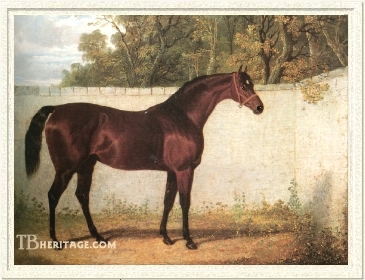 |
|
|
It's hard to overstate the influence of Emilius on the thoroughbred. He got many good racers, both sons and daughters -- including eight classic winners -- and it is through his daughters, and those of his sons, that he is seen in pedigrees today. He had an important impact on English and French breeding this way, and an incalcuable one on American pedigrees through the daughters and grandaughters of his several sons who were exported there.
His sire, Orville was one of the era's great four-mile horses, bred at Wentworth-Woodhouse, near Doncaster, by William Wentworth-Fitzwilliam (2nd Earl Fitzwilliam in England, 4th Earl in Ireland). Orville's dam, Evelina, by the great sire, Highflyer, was a four-mile runner, the product of generations of breeding at Wentworth-Woodhouse. Orville's sire, Beningbrough, was a great stayer who won the Doncaster Cup and the St. Leger, among other races and later sired two Oaks winners and a Doncaster Cup winner, in addition to Orville, an easy winner of the St. Leger. Orville, who was sold mid-career to the Prince of Wales, later King George IV, had a brief stud career in the Prince's stud near Newmarket, and then went to stud in Yorkshire. He got five classic winners, and was leading sire twice in Great Britain.
Emily, the dam of Emilius, was a good race mare owned by Colonel John Udney (sometimes Udny), a member of the Jockey Club and active racehorse owner in the first three decades of the nineteenth century. Udney had been born in Aberdeen and was a military attache to the Leghorn consulate in Italy, where his father served as consul, in the late eighteenth century. He owned the Sorcerer son, Truffle, a long-running racehorse who left some good foals in both England and France, and in 1818 won the Oaks and One Thousand Guineas with Corinne, trained by Newmarket wizard Robert Robson. Corinne was out of the Beningbrough Oaks-winning daughter Brisius, who, two years later, produced Abjer, by Truffle, for Udney. Abjeer's only loss in two years on the turf was his second place in the 1820 Derby.
Emily ran mostly at Newmarket in good company; she ran a match against Dr. Syntax, which she lost, and, in 1815, ran second to Muley in a handicap plate, beating Caper, Fugitive, and three others. She had been bred by Col. John Childers, owner of Carleton House and Carr House, near Doncaster, whose family had been breeding horses for generations; his great-grandfather was Leonard Childers, the breeder of Flying Childers and Bartlett's Childers. Emily's sire, Stamford, got some good racehorses, especially fillies, and his daughters were good in the breeding shed, producing such horses as Derby winner Mameluke and the outstanding race mare Fleur-de-Lis. Emily's dam, a mare by Whiskey, had other daughters who did well in the stud, including Diana (1808, sister to Emily), the dam of Actaeon, Oleander (1813, by Sir David), the dam of Oaks winner Wings (herself later a top producer), and a filly by Sorcerer, who was the dam of a good four-mile horse, Blackamoor. In addition to producing Emilius, Emily had a daughter, Emilia, by Udney's Abjer, who continued the female line of Family 28.
Emily's first foal, born in 1817, was a colt by Waxy, that died. Emilius, born in 1820, was her second foal, and Emilia, by Abjer, her third, born in 1823. After producing an 1824 colt by Orville that died as a foal, she was sold to the Duke of Portland, for whom she produced five live foals; she died in 1830, a month after foaling her colt, Autocrat, by Tiresias.
Emilius was a dark bay colt with his sire's plain head, albeit "not so coarse." Like his sire, he was muscular and compact; he stood on short legs, the hind ones somewhat straight, with well-sprung ribs and a muscular, arching neck. He looked, said The Druid, "...quite as much a hunter as a blood horse." He was put in training with the great Newmarket trainer, Robert Robson, who schooled so many classic winners for the Dukes of Grafton and Lord Grosvenor, and by the end of his long career in 1828 had won the classics thirty-three times.
Emilius, like many of Robson's charges, was the beneficiary of his advanced training methods, which did away with much of the harsh schooling methods of the eighteenth century; like Robson's previous six Derby winners, Emilius did not race as a juvenile, and his first sweat, something Robson, unlike his contemporaries and predecessors, mostly did away with, did not occur until prior to his first race in 1823. Emilius' jockey was always the great Frank Buckle, rider of twenty-seven classic winners, who was first jockey for Richard Grosvenor (1st Earl Grosvenor), and then rider for Robson, and so jockey for the Dukes of Grafton's many classic winners.
Emilius on the Turf
Emilius was undefeated in 1823, his first season at age three. He started first in the Riddlesworth Stakes at Newmarket Craven, winning £1500, beating Talisman, a colt of Phantom, and Tray, a colt by Filho-da-Puta. At the same meeting he took a walk-over for the 1500 guineas Dinner Stakes. In his last race before the Derby, a sweep at Newmarket First Spring, only one horse, the Soothsayer colt Fanatic, appeared at the post to challenge him, and Udney and and Fanatic's owner, Lord Exeter, agreed to divide the forfeits from the four other subscribers.
In the Derby he naturally started favorite, against a field nine other horses that included Tancred, Talisman, and Two Thousand Guineas winner Nicolo. He made all the running to Tattenham Corner, was briefly headed, and then surged forward to win, becoming Robson's last Derby winner, and Udney's only Derby winner. He went on to Ascot, beating the Whisker colt, Shaver, for 500 guineas at even weights. At Newmarket First October he outclassed the field -- which included Oaks and One Thousand Guineas winner Zinc (owned by the 4th Duke of Grafton and also trained by Robson), Nicolo, and another Orville colt, Bizarre, who would later win the Ascot Gold Cup -- in the Grand Duke Michael Stakes, worth 1200 guineas. His last race that year was a sweep for 800 guineas at Newmarket Second October, when he easily beat Cinder by three lengths.
After his brilliant three-year-old season, he lost form, and judging from his schedule, may have been plagued by some unsoundness; he only won one of his four starts at age four. He lost a 300 guineas match against the future Newmarket Oatlands winner, Augusta at Newmarket First Spring. He was put away until Newmarket First October, where he won a 500 sovereign match over the Abington Mile against the inferior Jock the Laird's Brother, by Viscount. A few weeks later he lost a 300 sovereign match to Bizarre, who had had a very good year, and at Newmarket Houghton he ran in his final race, the Audley End Stakes, where he ran last to Zealot and five other horses, an ignominous end to his brilliant career.
Emilius in the Stud
Thomas Thornhill, whose stud was at Riddlesworth, Norfolk, was partial to Beningbrough stock, and had won the Derby with Scud (Doncaster Cup winner, by Beningbrough) sons Sam (1820) and Sailor (1823). Squire Thornhill, by this time, had amassed an enormous girth, and had given up riding his favored trotting horses for a phaeton, which he drove over Newmarket heath to view horses in training. He purchased Emilius for 1800 guineas, developing a great fondness for him during his long career as a stallion, whose fee was 55 guineas in the latter years of his stud career. He himself had limited luck with Emilus' youngsters, Extempore being the only one of his classic winners by Emilius, but the horse's fame was cemented by his success of youngsters Thornhill sold as yearlings, and of youngsters foaled from mares owned by others.
Thornhill, who pre-deceased Emilius by nearly four years, specified in his will that the horse should never be sold. However, after Thornhill died in 1844, Emilius, age 24, was purchased by Lord George Bentinck, who took him to Welbeck; in 1847, "frisky" and in good health, Emilius was leased to Mrs. Robert Jacques, whose husband had bred and raced horses from their stud at Easby Abbey, where they had built a mansion on the hill overlooking the ancient ruins; Teddington, Birdcatcher and Longbow were all residents at Easby during the course of their stud careers. Emilius spent his last months there, covering mostly grade mares, getting "some very excellent" hunters, his last cover a piebald pony. At age 27, he had worn down his teeth and was unable to chew properly, and died in August, after having been mistakenly fed whole oats, which he was unable to process. He was buried in a paddock at Easby, his grave marked by a loose stone from the abbey ruins that had been part of a cardinal's tomb that was placed in the wall next to his burial spot. It can still be seen today.
Emilius was a very successful sire of racehorses, and exceptionally fashionable. He got two Derby winners, a Two-Thousand Guineas winner, a St. Leger winner, three One Thousand Guineas winners, and an Oaks winner, and their success propelled him to the top of the sire's list twice (1831 and 1832). His son, Priam, became a leading sire in England, twice, before being shipped off to the U.S., where he headed the U.S. sire list four times, before Glencoe and Lexington progeny sent them to the top. Other Emilius sons got some classic winners, but, the Beningbrough sire line effectively ended with Emilius and Orville's son, Muley. Still, Emilius' daughters and those of his sons had a major influence on the breed.
|
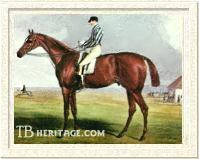
Riddlesworth
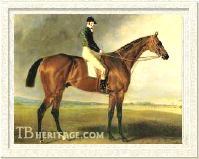
Priam | |
The chestnut RIDDLESWORTH (1828) was bred by Lord Jersey from his Soothsayer mare, Filagree, also dam of Cobweb (by Phantom), who won the Oaks and One Thousand Guineas; a good runner and sire Muley Ishmael; and other winners. Riddlesworth won the Riddlesworth Stakes and the Dinner Stakes at Newmarket, and went on to win the Two Thousand Guineas, with another Emilius son, SARPEDON, second. He also won the Newmarket Stakes. He was second to Spaniel in the Derby, Lord Jersey having declared another horse he owned in the race for winner which resulted in Riddlesworth being held back, when he otherwise would have won.
He was purchased by Sir Mark Wood, and then sold to Germany, in 1832. Tattersalls brought him back to England, where he covered mares in 1839, and then he was sent to Alabama, having been purchased by Dr. John C. Nott, where he became a successful sire, but not one that produced a good sire son.
|
PRIAM (1827), Emilius' first Derby winner, was also his best sire son, leading the list twice in England before being sent to the U.S., where he was the top sire four times. He was born in 1827, out of Cressida, by Whiskey. He was bred by Sir John Shelley (owner of Derby winner Phantom and his Derby-winning son, Cedric) at his farm in Sussex, who sent him and other yearlings to auction at Newmarket, where he was purchased by jockey Sam Chifney, Jr., his brother, trainer William Chifney, and trainer Montgomery Dilly (who trained MANGO for his St. Leger win) for 1,000 guineas. He was a dark bay colt who matured slightly over 15.3 hands, somewhat leggy, with a straight hind leg, a very refined head and a beautifully-angled shoulder.
PRIAM proved to be a great weight carrier who could win at any distance: he won seven of his eight races at age three, including the Derby, was unbeaten at age four in races that included the 2 mile-5 furlong Goodwood Cup, and won three of his four races at age five, including the Goodwood Cup again. Sold to George Stanhope, (6th) Earl of Chesterfield for 3,000 guineas, soon after the start of his second season, he was retired to Chesterfield's stud at Bretby Park at the end of his enormously successful career.
PRIAM was in England for four years, and was leading sire twice, in 1839 and 1840, after he had been exported to the U.S., having been sold by the financially-stressed Chesterfield to Edmund Tattersall on behalf of Dr. A.T.B. Merritt, whose company was responsible for importing into the U.S., on speculation, a number of high-class horses in the 1830s. He arrived in the U.S. in 1837 and was installed at Merritt's Hicks Ford stud in Virginia. In England, Priam left behind three classic-winning fillies, and a son, Giges, who was a successful distance runner in France and later a good sire there. A son, Monarch, born in England in 1834, was exported to the U.S. as a yearling, and became an unbeaten racehorse in that country, and later an influential sire of broodmares. In the U.S. PRIAM led the sire's lists four times, 1842, and 1844-46, and was second in 1843. Despite the production of numerous winners, it is only through his daughters and his sons' daughters that he had any lasting influence, which, in a way, is what was intended when he was imported, since American breeders of the 1830s were desperate for outcrosses on their in-bred American mares.
|
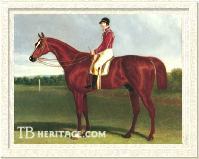
Plenipotentiary
| |
The "great fat bullock" PLENIPOTENTIARY (1831) was a favorite of the public, admired for his heavy beauty and running ability. He was bred by long-time Jockey Club member Stanlake Batson, of Horseheath, Cambridgeshire. Batson had owned some good race horses, including the filly Pranks (1809), who won the Ascot Gold Cup. "PLENIPO" was out of the excellent producer, Harriet (Family 6- b), who was by the good winner Pericles. In addition to Plenipo, Harriet produced, to different sires, the winners Mixbury, Luminary, and the fillies Revelry (third in the Oaks), and Voluptuary. "PLENIPO" was Emilius' second Derby winner.
|
PLENIPO grew to over 15.2 hands, with "bone and size enough to go between the shafts of a cabriolet," and was always in good flesh, even when racing. He had strong, easy action and excellent wind, and proved to have both stamina and speed. He was a difficult horse to manage on race days, kicking and plunging when it came time to saddle him, but otherwise was said to have a good temperament.
It should be noted that Thornhill's son-in-law later said that Thornhill's stud groom, Taylor, told him some years after PLENIPO had won the Derby that when Harriet came to Riddlesworth to be covered by Emilius, Taylor "did not think much of her," and instead put her to Merlin, who was also standing at Riddlesworth at the time (Merlin did not lack class as a sire -- he got Dervise, who won the Two Thousand Guineas of 1826, and the Claret Stakes at Newmarket and was second in the Oatlands at Ascot; Lamplighter, a good four-miler and winner of numerous matches and sweeps; Thornhill's good juvenile Merchant; also the good race mare Mangel-Wurzel and the excellent producer Mustard, dam of two classic winners bred by Thornhill).
PLENIPO did not start until the age of three, when he won a sweep at Newmarket Craven, beating three other youngsters. He ran again at the same meeting in a sweep, beating Glencoe, who two days earlier had won the Riddlesworth and was, until that race, believed to be the fastest horse of his day. In this race, Glencoe's jockey, Jem Robinson, had been told to beat Plenipo with Glencoe's speed, and Robinson later said, "I came the first half mile as hard as I could lick; but, on looking round, I saw the great fat bullock cantering by my side." Patrick Conolly, Plenipo's jockey, called over, "I'm here, Master Jemmy, only waiting until I'm wanted." And Plenipo proceded to run down the used-up Glencoe, winning by four lengths. His next race was the Derby at Epsom, where he broke first, then laid back while Glencoe sped ahead to lead the field, and then slowly gained to pick off all the horses, and easily held of a late challenge by the Chifney brothers' Shillelegh to win by two lengths. He went on to Ascot to take a walk-over for the St. James' Palace Stakes, worth £850.
His last race at age three was the Doncaster St. Leger, where he could barely be roused to get up in his stall before the race, stood quiety while being saddled, and tripped several times on the way to the course, Conolly remarking to trainer John Scott that PLENIPO was "dead as a stone." He was never in the race, which was won by Touchstone, and it was evident he had been gotten at, although it was some time before it was positively confirmed, Scott's head stable lad, one Mynott, confessing later (on his deathbed) to handing over the keys to Plenipo's box at Doncaster to an unnamed person. Several turf writers later noted that after this race, Plenipo's constitution was "utterly ruined." He did, however, go on to win the Craven Stakes at Newmarket in the spring of 1835, and at the same meeting won a 50 sovereign subscription plate, and took a walk-over for the Post Stakes, his last appearance on the turf.
Batson turned down an offer for him from American Commodore Robert Stockton, of either £5,000, or £1,000 a year for as long as the horse lived, a refusal Batson must have regretted later, because PLENIPOTENTIARY was a sore disappointment in the stud, and ended his days servicing half-bred mares for "a fiver." In England, his daughters were better runners than his sons, and he got two classic-winning fillies: the bright chestnut filly, Poison (1840, out of Arsenic, by The Colonel), won the Oaks (beating Emilius' One Thousand Guineas-winning daughter, Extempore) and Ascot's Trial Stakes at age three, and at age four took a walk-over at Ascot in a sweep and then ran for the rest of the season in top company, unplaced; and Potentia (1838, from Acacia by Phantom), won the One Thousand Guineas. Other daughters, such as Boarding-School Miss (1841), who walked-over for Newmarket's Coffee-room Stakes, also did well, if not brilliantly.
His best son was probably Ambassador (1839, out of Jenny Mills, by Whisker), who was imported (in utero) into the U.S. by Lucius Polk of Mount Pleasant, Tennessee. He won a number of races, including the $17,000 Alabama Stakes at Nashville, and later became a noted sire. Another son imported in-utero was Herald, from Delphine, who Wade Hampton II was finally able to obtain, after purchasing her offspring Monarch and The Queen, both by Priam; Herald was a very good runner in America, and in the stud got Heraldry (out of Margaret Wood, by Priam), from whom the bulk of the American Family A-1, with its many American classic winners and important sires, descends. Another Plenipo son that won, in England, was Envoy (1839, from Ayesha), who won the Drawing Wood Stakes at Goodwood.
Plenipo's daughters had influence on later generations: Delhi (1838, from Pawn Junior (Pawn Junior also dam of the aforementioned Dervise)) was the dam of Ellen Horne, head of extremely successful Family 1 - j and grandam of Rouge Rose, dam of Bend Or. Miss Betsy (1837, from a Whisker mare), produced two daughters whose descendants in tail-female make up Family 3 - c, which includes horses such as triple classic-winning filly Hannah (1868) and the influential American brothers, Chance Play and Chance Shot, Derby winner Teenoso (1980) being one of the more recent representatives of the family. |
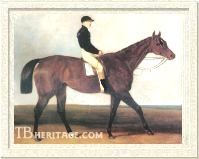
Mango
| |
MANGO (1834) was Emilius' St. Leger winner. He was out of Mustard, who was out of the Sorcerer mare, Oaks winner Morel, a sister to the good winner Truffle, later a sire in France. Mustard (1824) and her good racing sister, Mangel-Wurzel (1823), were bred by Thornhill from his stallion, Merlin, and for 8 guineas, Thornhill purchased their grand old dam Morel, age 20, when the (4th) Duke of Grafton put her in the Tattersall's sale at Newmarket in 1825. Mustard ran third to Atticus and Maria in the Prendergast Stakes for juveniles at Newmarket, in an exciting race she was favored to win.
|
In addition to MANGO, Mustard bred for Thornhill the One Thousand Guineas-winning sister, Preserve (1832), and also siblings Morella, Mangosteen, and the "E" youngsters, Emitic, Eringo, Elixir and Elemi, all winners by Emilius. Mustard heads the prolific and successful Family 1 - b, which descends via Preserve and Mangosteen.
The dark bay MANGO was 15.3-1/2 hands, muscular and with well-sprung ribs, like his sire. He was noted for being honest, but lazy, when running, a trait he shared with his grandsire, Orville. He was sold to Charles Greville, a long-time fixture in upper racing circles, a steward for the Jockey Club, who had served as racing manager for Frederick, the Duke of York, and was a specialist in arranging race matches and their terms, respected by his aristocratic peers and largely disliked by the racing public. He was a one-time racing confederate (partner) first of George Stanhope, Lord Chesterfield (owner of Priam), managing his racing interests; then his cousin, Lord George Bentinck (they quarreled and broke over Preserve's racing schedule), and finally George Payne, a well-respected owner and big gambler.
MANGO started in Grenville's colors once as a juvenile, in the Clearwell Stakes, in which he did not place. He came out as a three-year-old, in 1837, in a sweep at Newmarket Craven, where he enjoyed a walk-over. He did not place in Phosphorus' Derby. Next at Ascot, he did very well, winning first, the Ascot Stakes over 12 furlongs, beating Edgar and two others, and then, the same afternoon, winning a match over 12 furlongs against the filly Velure, and finally, later in the week, taking a sweep over a mile, in a punishing race in which he beat the Bizarre (by Orville) son, Rat-Trap by a neck. He then went on to Stockbridge, where the match was delayed for the arrival of Greville and Chesterfield, and won a very tight and hard-fought race by judge's decision against Wisdom.
His next race was the disasterous St. Leger of 1837, in which three horses fell (including the favored Epirus), and jockeys William Scott and John Day injured; MANGO, who had been trained for it by Montgomery Dilly at Littleton, and ridden by Sam Day, managed to avoid the two separate incidents, and won by three-quarters of a neck. At Newmarket First October he won the Newmarket St. Leger, beating three others by half a length, and in the Garden Stakes at Newmarket Second October, lost his only race of the season to Velure, with Castaway third. In that same day in a match scheduled against The Colonel, he received a forfeit.
At age four he was scheduled for six races, and won three: he received a 100 sovereign forfeit from Mahometan in a scheduled match; then won the Claret Stakes over the Ditch In at Newmarket Craven against one other four year old, Hibiscus, which he won easily by 3 lengths; and a £900 sweepstakes for four-year-olds, which he won "in a slovenly manner;" at the end of the week, he paid a forfeit to Velure for a scheduled match. In (First) October at Newmarket he was beaten by the mare Arsenic in a £200 match, MANGO "could scarcely raise a gallop," and he then paid a half forfeit to Caravan for a match that had been scheduled for Newmarket Second October, which was the end of his career on the turf.
MANGO was retired to stud at Hampton Court Paddocks at the modest fee of 11 guineas, and had little success as a sire.
|
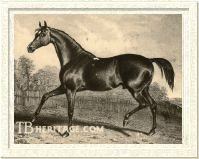
Recovery
| |
RECOVERY (1827), was out of a Rubens mare, an outstanding producer of some top winners. She was out of Waxy daughter, Tippetywitchet (Family 27) and it is through her Rubens daughter than most of the family descends. Recovery and his half-siblings -- which included One Thousand Guineas winners May-Day and Firebrand, Derby winner Phosphorus, and Ascot God Cup winner Camarine -- were bred by Colonel Robert Wilson who eventually acceded to his father's title, Lord Berners (9th Baron). |
RECOVERY was an exceptionally handsome chestnut that reached 15.2 hands when grown; when Matthew Wyatt was commissioned to execute a life-sized testimonial to Wellington, he chose Recovery as the model for the Iron Duke's charger, Copenhagen, who had since died and was not available for study. When the statue was complete, many knowing horsemen were appalled by the horse's lack of resemblance to Wellington's famous charger. The statue was erected in 1846 at Hyde Park corner, having taken almost 20 years to fund, design and cast. It was removed in 1883 and two years later re-erected at Aldershot, Hampshire.
At age three RECOVERY won three of his ten starts: a sweep at Newmarket First Spring for all ages, beating the good Glenartney and others; the Members' Plate at Ipswich over two-mile heats, and the Duke of Bedford's plate at Bedford. He was then sold to a Mr. Turner, and at age four he won two of his six outings, the Croxteth Stakes at Liverpool, and the Stand Cup at the same meeting, over two miles, beating the 1830 St Leger winner Birmingham. He fell lame running at Knutsford, still placing second, but never quite recovered, and failed to place in his three races in 1832, after which he was sold to George and Richard Tattersall, and retired to stud at Dawley Wall Farm, near Uxbridge, where Sir Hercules was briefly in residence. He sired some attractive horses, but none were particularly successful on the turf or in the breeding shed. |
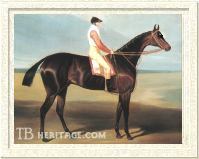
St. Nicholas
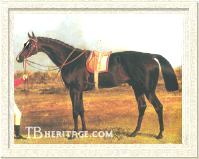
Euclid
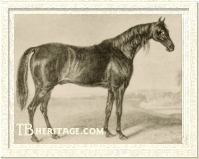
Theon
| |
ST. NICHOLAS (1827), was out of Sea Mew, a sister to Derby winner Sailor, by Scud. He was bred by Thornhill and later sold to blacksmith, some-time horse doctor, and heavy gambler Francis Richardson, who had been implicated in the losses of several St. Leger hopefuls. He named the dark brown colt for the place where he lived, near York. St. Nicholas won two races in 1830 out of four starts, which included the St. Leger, in which he did not place.
ST. NICHOLAS got a nice filly in Orelia, who won the Goodwood Stakes twice in successive years, and the Liverpool Cup. He also sired two brothers in-bred to Beningbrough, Yorkshire and Nicholas (out of a Tramp mare, Miss Rose), who were imported into the U.S. by R.D. Shepherd. Yorkshire was sold to Commodore Morgan, and could win up to two miles, but no more; Morgan gave him to Henry Clay, whose son, John, bred many good winners from him. His daughters were very good producers. A Yorkshire son, Lodi (in-bred to Orville), was the top horse in California, until defeated by the great Norfolk; Yorkshire also sired Bay Leaf, dam of Saratoga Cup winner Preakness, later sent to England to run, and tail-female ancestress of the influential sire, Bramble. In 1840 ST. NICHOLAS was sold to Germany, where he got some good winners, including Union-Rennen winners Lionel (1848) and Uriel (1850).
EUCLID (1836), was out of Maria, by Whisker (Family 7 - a). Maria was out of Gibside Fairy, owned by John Bowes, (10th) Earl of Strathmore, and was a sister to Emma, the dam of Derby winners Mundig and Cotherstone, and of Mowerina, the dam of Triple Crown winner West Australian. Maria and Emma had been bred by the trustees of the estate of the Earl, who died in 1820, whose seat was Streatlam Castle, County Durham, and also owned Gibside Park, 40 miles from Streatlam. The Earl had been a racing enthusiast who maintained a stud first at Esher, Surrey, then at both Streatlam and Gibside, and had won the St. Leger in 1803 with Remembrancer.
|
His son, John Bowes, who was to breed three Derby winners, including the great West Australian, was not yet of age when Maria ran in the name of one of the Earl's trustees, William Harry Vane, (1st) Duke of Cleveland. She won a number of races, including the York Gold Cup and the Great Subscription Purse at York in 1831, the King's Plate at Lincoln, and a Silver Tureen and the King's Plate at York in 1832.
As a broodmare, Maria was lodged at, if not in the possession of, Thornhill, who is credited with breeding six of her eleven live foals, every single one by Emilius, and a good "nick" it was. Their offspring included EUCLID, her third foal; his brother THEON (1837); the filly EXTEMPORE (1840), who won the One Thousand Guineas for Thornhill, and MATHEMATICIAN, sold to ex-pugilist, gambler and sporting man John Gully.
EUCLID was another handsome son of Emilius', with the characteristic heavy muscle, good size (he grew to 15.2 hands), and unlike some Emilius offspring, he had good legs; he had a short, but quick and elastic stride. He did not start racing until age three, and was an almost winner of the Doncaster St. Leger, dead-heating with the very good horse, Charles XII, despite being driven into the rails several times by Charles XII's jockey, Bill Scott. His owner, Thomas Thornhill, not unnaturally, thought Euclid had won the race, as did a number of the onlookers. The run-off was another close, desperate race, which Charles XII won by a neck.
EUCLID'S other performances that season included a second in the Riddlesworth Stakes at Newmarket Craven (only two ran) and two wins, one in a £600 race at the same meeting in a race for three-year-olds, and a second in a sweep at even weights for £250. He did not place in Bloomsbury's Derby, but went on to Ascot to win the St. James' Palace Stakes, a Produce Sweep, and a walk-over in a small race. After the St. Leger, he went to Newmarket First October, where he won the Grand Duke Michael Stakes, again in a run-off, this time against the St. Patrick colt, Aether, and at the same meeting won a small race over a Buzzard colt.
At age four he started well, but lost form in the second half of the season. He won a sweep at Newmarket Craven, beating two good colts, and also won the Claret Stakes there, beating the Two Thousand Guineas winner The Corsair. At Newmarket First spring he won a 300 sovereign match against The Corsair, his last victory of the year. He went on to run unplaced in the Ascot Gold Cup, the Goodwood Cup, and Goodwood's Steward's Cup, and was then retired to Thornhill's Riddlesworth stud in Norfolk. Thornhill had written to Andrew Johnstone, who was creating a stud at Sheffield Lane Paddocks, that he was not interested in selling EUCLID to Johnstone..."Had Euclid only three legs I would not take 2,000 for him as a stallion." Johnstone later purchased Charles XII.
EUCLID died fairly young. He left a daughter, Eulogy (1843, from Martha Lynn by Mulatto, Family 2 - h), half-sister to Derby and St. Leger winner Voltigeur and Yorkshire Oaks winner and great producer Vivandiere, all bred by Robert Stephenson of Hart, Hartlepool. Eulogy, like her dam, was an outstanding producer. Her son, Martyrdom, won the Prince of Wales's Stakes. Her daughters included: Imperiuse (1854), winner of the One Thousand Guineas and the St. Leger, who heads her own branch of Family 2 (Family 2 - j); Cambridgeshire Handicap Stakes winner Eurydice (1855); Park Hill Stakes winner Imperatrice (1859), who heads the branch labeled Family 2 - k; Clemence (1865), dam of many good producers, including Clementina (1880), who produced the French crack Le Samaritain, and Coronation Stakes winner Sandiway (1881), who became tail-female ancestress of a number of good winners and had an influence on American pedigrees through her daughter, Sandfly.
EUCLID'S son, Bantam (1843, from Lady Fanny by Dr. Syntax), was bred by Mr. Courtney, in Ireland. In the stud he sired the grey Zouave for Courtney, who won over fences and later became a successful sire of steeplechasers, including the small, game The Lamb, winner of the Grand National Steeplechase at Aintree in both 1868 and 1871.
Euclid's brother, THEON (1837), "a good hardy brown," more refined than other Emilius offspring, was one of Maria's foals owned by Cleveland. As a juvenile, he won once, a sweep at Doncaster, beating the good Launcelot and six others, placed second to DeClifford in the Mersey Stakes at Liverpool, and failed to place in Doncaster's Champagne Stakes. At age three he won a sweep at Newmarket Craven, but failed to place in the Derby, his last race. He retired to Raby Castle, the Duke's seat in Durham, and stood at stud there until the Duke's death, after which he was sold; even at age twenty his was still admired for his beauty. The Duke's passion was hunting, and Theon was used largely on half-bred mares, getting "hunters as good as they can be, with much more size and substance than himself."
MATHEMATICIAN (1844), brother to EUCLID and THEON, was a solid runner who won the Great Ebor Handicap in 1847. Of his offspring, his daughter, Algebra (1852, from a mare by Comus) was probably the most influential: she produced the good stayer Lecturer (1863), who won the Ascot Gold Cup, the Cesarewitch Stakes, and the Queen Alexandra Stakes, and later was a good sire, and a daughter, Puzzle (1862) that bred on.
POMPEY (1840, from Variation by Bustard), ran second in the Riddlesworth Stakes in 1843 to Cotherstone, and went on to win the Great Yorkshire Handicap that year; in 1844 he won the Great Yorkshire Handicap a second time, and also ran second to Knight of the Whistle in the Chester Cup. He was a moderately successful sire, his best winner by far the powerful filly Nancy (1848, from Hawise by Jereed), a long-running game filly in the north of England, whose wins included the Two Year Old Stakes at Northallerton, the Chester Cup, the York Cup (in which she beat Votigeur), Newcastle's North Derby, the Goodwood Cup (in which she beat Cossack, Landgrave, Cariboo and others), the Great Ebor Handicap, and the Great Yorkshire Stakes. She sprained her hind leg in a training gallop on Knavesmire towards the end of her three year old season, and although was entered in the premier races in the north in 1852, '54 and '55, she never placed again. She broke her leg running in the 1855 Chester Cup, and was destroyed on the spot.
Some Emilius Sons Abroad
In addition to PRIAM and his son MONARCH, and Plenipotentiary's son, AMBASSADOR, other Emilius sons were exported to the U.S., and to France, where they had an influence on the bloodstock in those countries. They were part of the wave of buying sprees in England by the French government and wealthy Americans seeking to improve thoroughbred bloodlines and provide outcrosses for in-bred breeding stock. |
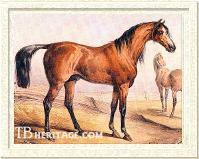
Young Emilius
| |
YOUNG EMILIUS (1828, from Cobweb by Phantom, Family 1 - s), was a close relative of Emilius' Two Thousand Guineas winner Riddlesworth. Cobweb was a top race mare who had won both the Oaks and the One Thousand Guineas, and was equally good as a broodmare in Lord Jersey's stud, dam of a very good racehorse in the gelded Mahomet (1832), and of the good runner and influential sire, Bay Middleton (1833). Young Emilius was her second foal. He was purchased in 1832 by Ernest Leroy, representing the Societe d'Encouragement, and sent to France, where he stood at various studs around the country, including Bayeaux in 1836, Le Pin in 1837, and Paris in 1845. He got a number of good running sons, and some excellent daughters that bred on, including Emilia, the dam of the influential American stallion Australian. |
YOUNG EMILILUS' son, Fitz-Emilius (1842, from Miss Sophia, by Shakespeare, Family 9 - d) was bred by Alexandre Aumont, a member of the French Jockey Club and owner of one of the most successful racing stables and breeding establishments in France, Haras de Victot. He and his son, Paul, were fond of Emilius bloodlines, Paul was later the owner of Royal Quand-Meme, a son of Giges, by Priam. Fitz-Emilius won the top juvenile race, the Criterium, and the next year was the champion runner of 1845 in France, winner of the Premier Criterium at Chantilly; the Prix du Printemps; the Prix du Jockey Club, beating the great Suavita; the Derby Continental at Gand (3200 meters), and other good races at Versailles, Caen and Le Pin, a total of nine wins. The next year he won 7 races, including the Prix des Pavillons, the Prix Royal (Chantilly), the Grand Prix Royal (Champ-de-Mars, over 4,000 meters, later Prix Gladiateur), and the Prix des Haras (Chantilly). In 1847, he won the Prix des Pavillons again, the Prix Special in Paris, and several victories in other venues; in 1848 Alexandre Aumont sold his bloodstock, and Fitz-Emilius was sold to Jules Riviere, for whom he won the Prix de la Foret over 6,000 meters.
YOUNG EMILIUS' son Renonce (1840, from Miss Tandem by Tandem) was owned by Celestin de Montalba. He was a good juvenile that won a 2,000 franc stakes race for colts, and and ran second to The Drummer in the big juvenile race, the Criterium. At age three, going off at odds of 60 to 1, he dead-heated for the Prix du Jockey Club with Thomas Carter's Prospero. Rather than split the stakes, the owners opted for a race to determine the winner, because, in addition to the 20,000 francs, a ruby and pearl domino set that had belonged to Marie Antoinette was a prize to the winner. Renonce won the run-off and the domino set. He went on to win a 4,000 franc race at Versailles later in the year.
Amalfi (properly by Gladiator or YOUNG EMILIUS) (1848, out of Tarantella, by Tramp) was probably a three-quarter brother to Gambetti (below), who was by Emilius and out of Tarantella. He was bred and raced by Auguste Lupin, who had imported Tarantella in 1840. In 1851 he won the Prix du Jockey Clup. Other Young Emilius offspring who won that year were Electrique (from Kermesse) who won six races in 1851, and nine the following year, and Debardeur (from Dona Pilar) who won Saumur's Derby de l'Ouest.
YOUNG EMILIUS also got Bathilde (1842, from Odine, by Tigris, Family 5 - g), who never raced. In the stud she produced a series of good daughters, including Camisole (1856, by Gladiator), who produced Fille de l'Air (1861, by Faugh-a-Ballagh) one of the great fillies of the French Turf, who also won the Epsom Oaks and other top races in England and herself was dam of dual-classic winning filly in England, Reine. Other tail-female descendants of Bathilde included such horses as German Derby winner Ferro, later an influential sire in Germany; the sire Fra Diavolo; the good French-bred sons of Le Sancy, Champignol and Chambertin; Two Thousand Guineas winner Gilles de Retz (1853), and a host of other good runners. A sister to Bathilde, Belle de Nuit (1844, by YOUNG EMILIUS), was the dam of the French Derby winner Ventre St. Gris (1855, by Gladiator), later a good sire.
Another Emilius son who did well in France, this time as a racehorse, was GAMBETTI (1845), out of One Thousand Guineas winner Tarantella (1830, by Tramp). Tarantella produced Polka (by Emilius), who bred on (Family 22), and two sons who won the Prix du Jockey Club (French Derby), Gambetti and the aforementioned Amalfi, the latter probably by Young Emilius. Gambetti, running for Lupin, was the best of his generation at age three, winner of the Grand Saint-Leger, the Poule d'Essai (French Two Thousand Guineas), the French Derby, the Prix des Pavillons, and two other races. The next year he picked up two rich races, the Prix des Pavillons and the Prix du Ministere du Commmerce, and then was retired.
|
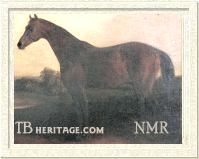
Sovereign
| |
The bay SOVEREIGN (1836 from Fleur de Lis by Bourbon), was purchased from the Hampton Court Stud and imported into the U.S. as a yearling by Wade Hampton II. He was injured and never raced, and was used by Hampton at a stallion, starting in 1841, first standing at the Columbia, S.C. Racecourse for a fee of $60. He was later sold to Kentucky, where he stood, from 1852 on at Colonel Abe Buford's Bosque Bonita Stud in Woodford County. He became an influential sire, frequently crossed on daughters of Leviathan and Glencoe, as well as native-bred mares, producing some top race horses of the mid-nineteenth century; his many successful daughters bred on, and his name strongly is woven into the fabric of American pedigrees. |
Probably his most famous daughter was Prioress (1853, from Reel, Family 23), a successful winner in both America and England, when shipped there by her owner, Richard Ten Broeck. Her sister, Fanny Wells (1858), produced Nellie Grey and Jils Johnson, both stakes winners; Jils Johnson was later a sire seen in pedigrees today through his daughter, Belle of Nantura. Rosaline, a sister to Nellie Grey, became tail-female ancestress of such horses as champions and top broodmares Two Lea and Chris Evert. Another outstanding daughter by Sovereign was W.J. Minor's La Vraie Reine (1848, out of Veracity, by Pacific), winner of eleven races between one and three miles in succession between April 1851 and April 1852, without losing a single heat; she broke down in 1853, having been pushed too hard. Another Sovereign daughter, Dixie, produced an outstanding son in Herzog; her tail-female descendants included Rough n' Tumble, War Relic, and He Did.
SOVEREIGN was almost always in the top-ten of leading sires and was first in 1852 and second in 1865 (based on number of races won), and got several sons, including Mahomet (1848) and Childe Harold (1842) who became sires of winners. His son Ruric was a good runner and his unnamed sister, both from Levity (by imported Trustee, out of Emma), established a long line of tail-female descendants who that included top stakes winners (Family 12 - b). |
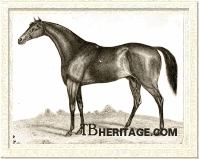
Sarpedon
| |
SARPEDON (1828, out of Icaria, by The Flyer) was another good Emilius son who was shipped to the U.S. Bred by Richard Grosvenor, who also raced him, he won eight of his nineteen races at ages three and four in England, including the Bilsbury and Stamford Gold Cups, and ran second to Riddlesworth in the Two Thousand Guineas. He broke down in the running of the Goodwood Stakes in 1832 and was retired to stud at Newmarket, where he covered a few mares before being purchased and imported by Merritt and Company into the U.S. He first stood in Virginia, and then was sent to Kentucky; he was among the leading sires of his day, getting some very good winners, including Louis d'Or (1847), one of the fastest distance horses in his time. |
SARPEDON'S principal contribution to the breed, however, was his daughter, Alice Carneal (1836, from Rowena, by Sumpter), a modest race mare who won a Jockey Club purse at age five, and who in the stud produced the most influential American sire of the 19th century, Lexington (1850, by Boston), and also Umpire (1857, by Lecomte). Umpire was sent to England by his owner, Richard Ten Broeck, and won thirteen stakes and three matches there, later siring Wrangle (1875), from whom Oaks winner Quashed descended (Family B - 3).
Other Emilius Sons
Other good running sons of Emilius included: THE CASTER (1840, from Castaside by Camel), who won the Levant Stakes and the Molecombe Stakes at Goodwood; ELEMI (1841, a brother to MANGO, et. al.), winner of the Riddlesworth Stakes at Newmarket; CHAPMAN (1829), winner of Newmarket's Craven Stakes, in which he beat PRIAM; EXILE (1828), winner of Warwick's Leamington Stakes; CIUDAD RODRIGO (1828), winner of the Gold Cup at Brighton; MARCUS won a purse at Newmarket Second October as a juvenile, and a £1200 sweepstakes at Newmarket Craven in 1831; AGREEABLE won the Somersetshire Stakes at Bath, a £700 stakes at Newmarket and ran third in the Goodwood Stakes in 1831.
Daughters of Emilius
Emilius sired four classic winning fillies, and some other daughters that ran well. A number were good juveniles, and some were also good distance mares. As a popular stallion Emililus attracted quite a few well-bred mares, a number of which had been good on the turf, so it is not surprising that many of his daughters had a great influence on the breed, heading their own branches of various Bruce Lowe families. |
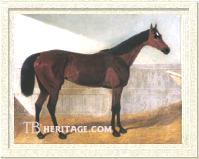
Oxygen
| |
OXYGEN (1828) was bred by the (4th) Duke of Grafton at his Euston stud; she was out of a Grafton stud-bred mare, the One Thousand Guineas winner Whizgig, by Rubens (Family 1 - o). Oxygen was a high-class filly with good speed, and she could also go and win at four miles; she was Emilius' sole Oaks Stakes winner. Her sister, OCTAVE (1830), was also a good runner, who won the Derby and Oaks Challenge Stakes at Newmarket in 1833, and ran second to Vespa in the Oaks .
|
OXYGEN was a good juvenile, who won the Anson Dinner Stakes at Newmarket and the Clearwell Stakes, and ran second to Zany in the July Stakes; her speedy performances ranked her second best two year old of her generation, and the following year she was the indisputed leader of fillies.
At age three she enjoyed a walk over the Abingdon Mile at Newmarket in her first outing, then did nothing in the One Thousand Guineas, surprising her supporters. Her next race, at Epsom, was the Oaks, which she won, beating the favored Circassian. This was followed by a sweepstakes for fillies over a mile at Ascot, easily beating the second and third place Oaks finishers, Marmora and Guitar. In the fall she ran second to Camarine in the Newmarket St. Leger, and a few weeks later took a walk-over for forfeits in a stakes. At age four she came out strongly in the Oatlands at Newmarket Craven, beating the good runner Mazeppa by a length, at at Newmarket First Spring won a King's Plate in a speedy race over four miles, beating Lucetta. She met Lucetta again at Newmarket for the Jockey Club Plate over four miles, but ran second, and followed that race by two more in the fall, where she failed to place. She ran once in 1833, age five, in the Oatlands, and was beaten by the filly Dinah, after which she was retired to the Duke's stud at Euston.
OXYGEN'S chestnut daughter Currency (1837, by St. Patrick), bred and owned by the (4th) Duke of Grafton, was a good juvenile, running second to Crucifix in Newmarket's July Stakes. In France she bred two top winners, Saint Germain (1847, by Attila), who won both the Prix du Jockey Club and the French Two Thousand Guineas and was later a good sire, and the outstanding race mare Jouvence (1850, by Sting), winner of the Prix du Jockey Club, the Prix de Diane (French Oaks) and other races in France, and the Goodwood Cup in England. A number of other good winners descended from Oxygen's daughter Cavatina (1845, by Redshank). |
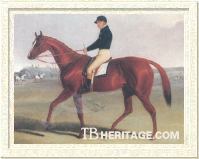
Preserve
| |
PRESERVE (1832, Family 1 - c) was out of Mustard, by Merlin, and so sister to Mango and Mangosteen. She was another fast Emilius daughter that could also go a distance, bred by Thornhill, and owned by Charles Greville. As a juvenile she won the Clearwell and Criterion Stakes and a 300 guineas match at Newmarket October. At age three she became the first of three Emilius daughters to win the One Thousand Guineas, but was unable to beat the superior Queen of Trumps in the Oaks, to whom she placed second. She ran for another year, winning the Drawing Rooms Stakes at Goodwood and placing second to Glaucus in the Goodwood Cup.
|
In the stud, PRESERVE produced Jamaica, the dam of a very good stayer, Yellow Jack (1853, by Birdcatcher), who ran second in the following races: the Two Thousand Guineas, the Derby, the Chester Cup, the Ascot Derby and the Goodwood Cup. Such horses as Oaks winner Brownhylda and St. Leger winner and sire Firdaussi descend in tail-female from Preserve. Another sibling to Preserve, MARMALADE (1838) was a good runner who placed second to Elis in the Clearwell Stakes and third to him in the Prendergast Stakes as a juvenile, and at age three second to Cyprian in a well-run Oaks Stakes; Marmalade was later sold to Germany.
BARCAROLLE (1835, Family 45) was the second Emilius daughter to win the One Thousand Guineas. She was one of several foals by Emilius bred by Thornhill from Bravura, an 1821 daughter of Outcry, and was sold to William Charles Keppel, (4th) Earl Albemarle, who was Master of the Horse for King William IV and then for Queen Victoria, who was crowned the same spring Barcarolle had her classic win. She, and other top fillies of her generation came down with some kind of virus just prior to the running of the Oaks and were unable to compete in it, paving the way for Priam's daughter, Industry to win it. Barcarolle was sold to Russia in 1840.
EXTEMPORE (1840, Family 7 - a), the third One Thousand Guineas winner by Emilius, was out of the aforementioned Maria, by Whisker, and so sister to EUCLID, THEON, MATHEMATICIAN and others from this good cross. She was also bred by Thornhill, and raced in his colors, his only classic winner by Emilius. A speedy filly, she had won the July Stakes as a juvenile. She only produced four foals, dying in 1854, but one of them was her bay daughter, Jeu d'Esprit (1852), by Flatcatcher, who became a top producer and heads her own branch of Family 7 (Family 7 - d). Jeu d'Esprit had a number of daughters through which the family flourished: the sires Wisdom and Mieuxce both descend in tail-female from this family. Jeu d'Esprit's daughter, Feu de Joie (1859, by Longbow), who won both the Epsom and Yorkshire Oaks, and other daughters -- Jeu de Mots, Charade and Saracasm -- all established successful branches with tail-female descendants that included such horses as English Triple Crown winner Flying Fox and St. Leger winner and influential sire, Wildfowler.
Other Emilus daughters who ran well included MOUCHE (1827, from Mercy, by Merlin), who won the Clearwell Stakes; THE DRAMA (1836, out of Farce, by Swiss) won the Lewes Stakes, and after producing two foals in England was sold to Baron Kotze and sent to Germany; LADY EMILY (1826, from Antiope by Whalebone) -- half-sister to the good race filly Dirce (by Partisan) and Cambyses (by Camel) -- beat a good field in the Brighton Cup at age four, and was later sold to the U.S. TRAGICAL (1843, from Ophelila, by Bedlamite) won the Royal Hunt Cup.
In addition to the good producers noted previously, Emilius sired other daughters who were influential in the breeding shed. Some of these are listed below.
EUSEBIA (1839, out of Mangel Wurzel, a sister to Mustard (dam of Mango, etc.), Family 1 - b) was imported into France in 1844 by the Comte de Cambis for the Royal stud at Meudon. She became the dam of the in-bred Royal Quand-Meme (by Priam's son, Giges), who won more than 80,000 francs in his years on the turf. She also produced three highly influential daughters in France: Echelle, a good stakes winner and the dam of Orphelin, who got Revigny (French Two Thousand Guineas, French Derby), Montargis, and Reine-de-Saba, among others; Comtesse, the dam of the Ascot Gold Cup winner and later good sire, Mortemer; Liouba, the dam of two good runners, Le Mandarin and Marengo. Eusebia's sister, EMPRESS (1837) became the tail-female ancestress of good winners, and another sister, ELUINA (1840), was ancestress in tail-female of a great many good horses, including Troy (1976) the winner of the Irish and Epsom Derbies, among other top races, and the great stayer French Beige (1953), who won the Doncaster Cup, the Jockey Club Stakes and other races.
EMILIANA (1829, from a Whisker mare, Family 3 - c) was a half-sister to the good colt Shillelegh, and like him was purchased as a yearling by trainer William Chifney and ridden by his brother, Sam. She was a top juvenile, winner of the Clearwell Stakes and Prendergast Stakes, but over the winter "got a leg," which affected her classic hopes. Later in her three year old year she ran second to Galata in the two mile Port Stakes. She became the second dam, tail-female, of One Thousand Guineas winner Mentmore Lass, herself dam of Oaks winner Hannah and second dam of Derby winner Favonius.
Many other Emilius daughters can be seen in the tail-female ancestry of numerous stakes winners throughout the world, for example Nameless (1831, from Problem, Family 1 - g) was fifth dam of dual-classic winner Pilgrimage (1875), dam of Derby winner Jeddah and of Oaks winner Canterbury Pilgrim, the latter dam of Chaucer and Swynford. Another filly, Moorhen (1830, from the classic winning Shoveler, by Scud, Family 6 - c), was tail-female ancestress of many classic winners in Hungary.
--Patricia Erigero
|
|
|
|

